Sorry I haven’t posted this week. So much time and so little to do.
Wait a minute. Strike that. Reverse it.
One thing I have made room for in recent days is this Cosmoetica interview with screenwriter Lem Dobbs, whose credits include Dark City, The Limey, and The Limey’s commentary track, which is so good it deserves to be treated as a separate project. The interview is truly epic – 53,000 words, 90 pages – wide-ranging, and brutally honest. It’s also one of the best things I’ve read in years. Some excerpts:
Books are published now – crime novels, for example, which is a field I still follow – that are so horrible, it’s mind-boggling. Covered in laudatory review quotes and blurbs, listing all the awards they’ve won – you can’t believe it. It’s quite often impossible to find a bad review of a book, that’s how much of a racket it’s become.
I agree with him. Which kills me, because when I read a lousy crime novel – and lately I’ve read a few, all blurbed by writers I respect and touted elsewhere – I hold my tongue. Bill Crider recently summed up my feelings on the subject of reviews perfectly. I don’t see myself as a critic. I like to use my tiny corner of the internet to call attention to the good stuff. But every once in a while, when for reasons of my own I finish a book that’s a dud, I question that approach.
Dobbs on Hollywood now:
They’d much rather hear what they think is a “cool take.” But not knowing what’s old, they have no idea what’s new. So the whole phony, broken system is an exercise in futility and another reason movies are much more uniform in their awfulness. There’s absolutely no patience for, or respect or appreciation for, ideas outside the airless dome of a very limited frame of reference. If you engage in a discussion of who the “villain” is, for instance, you’d better do it in an excited and animated way (this is why it’s helpful to have a writing partner who’s also wearing big ol’ baggy shorts and a Hawaiian shirt and a turned-round baseball cap and chortling) – because to roll your eyes and sigh and question whether there even has to be a villain would be to challenge the whole current paradigm. And the “villain,” of course, once established, has to be motivated by nothing less than destroying the entire world – and so on – from cliché to cliché. If you’re unwilling to – sincerely – play this game, you might as well stay home ... Who was the “villain” in THE GREAT ESCAPE, or THE DIRTY DOZEN? Remade now – and don’t think they’re not trying – there would have to be an evil, evil, evil, evil Nazi in alternating scenes, constantly snarling, “I want them caught, I want them stopped, I want them dead!”
Bookmark it. Go back to it in stages. It’s worth the effort.
Friday, January 29, 2010
On The Web: Lem Dobbs
Monday, January 25, 2010
Book: The Writing Class, by Jincy Willett (2008)
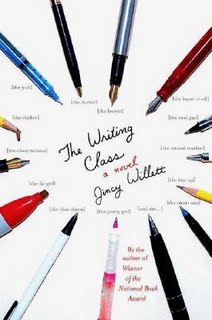 Amy Gallup is a middle-aged loner who hates being alone, a once-promising novelist who now teaches adult extension creative writing courses. She’s been at it for so long she can instantly size up each new group during the first session, knowing at once which students are wasting their time and hers. Then someone in the class begins sending odd notes. Biting parodies, obscene drawings, critiques that cut too close to the bone. The notes turn into pranks, then the pranks become deadly. And nobody really wants to the read the surgeon’s medical thriller.
Amy Gallup is a middle-aged loner who hates being alone, a once-promising novelist who now teaches adult extension creative writing courses. She’s been at it for so long she can instantly size up each new group during the first session, knowing at once which students are wasting their time and hers. Then someone in the class begins sending odd notes. Biting parodies, obscene drawings, critiques that cut too close to the bone. The notes turn into pranks, then the pranks become deadly. And nobody really wants to the read the surgeon’s medical thriller.
Jincy Willett’s darkly funny novel is ruthless when it comes to the teaching of fiction. The samples of each student’s work are priceless. But every barb contains useful writing advice. The book is also an affectionate portrait of a prickly character in Amy, and a sly treatise about what motives people to read, to write, to connect. I missed this book when it was published initially. Thanks to my friend Chad Jones for the recommendation.
Miscellaneous: Elsewhere
What I Learned on Twitter. I’ve spoken before about The Three Investigators books, which got me hooked on crime fiction as a tyke. Turns out the boys are so popular in Germany that there’s a movie. Here’s the trailer.
I’d Link If I Could. The article on the cryonics movement in the January 25 issue of the New Yorker (not online unless you’re a subscriber) is fascinating reading. Jill Lepore analyzes several of the Amazing Stories yarns that inspired Robert Ettinger to start freezing people. Ettinger is the kind of crackpot utopian visionary – briefly famous in the 1960s and 70s, interviewed by Johnny Carson, David Frost and others – that we don’t see enough of any more. A taste of Lepore’s article:
In ‘Man Into Superman,’ Ettinger throws around a lot of Nietzsche and George Bernard Shaw, but shows more evidence of having whiled away the hours reading Penthouse, which began publication in 1965. The world of tomorrow will be unimaginably better than the world of today. How? There will be transsex and supersex! Scientists will invent “a sexual superwoman ... with cleverly designed orifices of various kinds, something like a wriggly Swiss cheese, but shapelier and more fragrant.” Animals will be bred as sex slaves; even incest might be allowed. Also, scientists will likely equip men with wings, built-in biological weapons, body armor made of hair, and “telescoping, fully adjustable” sexual organs. (Hold on. That last one. Doesn’t the existing model already come with that?)
Thursday, January 21, 2010
TV: The Greatest Broadcast in the History of the Medium
Five years ago today, a landmark broadcast went out over the airwaves ... of digital cable. An episode of the Independent Film Channel’s Ultimate Film Fanatic, featuring yours truly as a contestant.
The strangest thing about the show is that a few weeks after it taped, Rosemarie was selected to be on Jeopardy! Making 2005 our year of game shows.
UFF’s entire run lives on via YouTube. So I might as well mark the occasion by embedding it here. Again.
Two vital points before watching –
1. I now have the sense to wear contact lenses.
2. Also, my hair looks much, much better.
First, intros and round one: trivia. We were asked to come up with our own opening lines, which the producers then “improved.” Still, I sell the moment and cap it off by staring down the camera Lee Van Cleef-style.
I had a strategy in this round. My competitor is Tom Tangney, critic for several Seattle radio stations, and I knew from our pre-show conversation that he was an erudite gentleman of taste. I therefore decided to force him to answer questions about crappy thrillers, which I regard as my forte. Watch as careful planning almost blows up in my face.
Round two: debate. (Spoiler alert: I make it through round one. To this day, I can’t believe I remembered the name of that damn doll.) Your celebrity judges are Academy Award winner Tatum O’Neal and certified badasses Keith David and Henry Rollins.
The producers stopped tape before this round to ask for topic suggestions. I confess that Kevin Costner was my idea. Again I had a strategy, namely degree of difficulty. If I could ably defend an unpopular position, maybe I’d earn the judges’ respect. For the record, I stand by the argument I made and would add the additional exhibits of The Upside of Anger and Mr. Brooks. As for Rumor Has It ...
Round three: obsession. Or as I thought of it, collections.
In a rare moment of prescience, I announced to Rosemarie after my audition, “If I get on the show I’ll make it all the way to the third round, then crash and burn.” Which is exactly what happened. See for yourself. Any of the other contestants would have fared better than me in this section.
Problem #1: I don’t collect things. Scrounging up three items was a reach. (BTW, the key broke on the flight home.)
Problem #2: I’m up against Tony Kay, now host of Seattle’s Bizarro Movie Night. I didn’t stand a chance.
Note the raw sexual chemistry between Tatum and myself. What Rollins says about me is still one of the high points of my life. It was almost worth losing the five grand in prize money to be spared his scorn. Almost. And my popcorn line was used in TV spots throughout the season, so I won the battle for airtime.
In closing, my hair really does look better now. Honestly. I can’t stress that enough.
Monday, January 18, 2010
Movie: Big Fan (2009)
The directorial debut by former Onion editor and screenwriter of The Wrestler Robert Siegel received only a token theatrical release. Now on DVD and streaming via Netflix, this unsettling, darkly hilarious film can find the audience it deserves.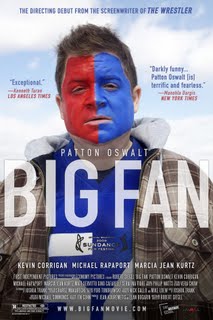 Paul Aufiero (Patton Oswalt) is a 36-year-old parking garage attendant who still lives with his mother. Two things get him out of bed every day: the New York football Giants and the few minutes each week when he gets to be “Paul from Staten Island” on a sports radio call-in show. One night he has a chance encounter with his favorite member of the team’s starting line. Only his dream moment ends up going wrong. Badly wrong. Several days in the hospital wrong. What do you do when your one true passion in life literally and figuratively kicks your ass?
Paul Aufiero (Patton Oswalt) is a 36-year-old parking garage attendant who still lives with his mother. Two things get him out of bed every day: the New York football Giants and the few minutes each week when he gets to be “Paul from Staten Island” on a sports radio call-in show. One night he has a chance encounter with his favorite member of the team’s starting line. Only his dream moment ends up going wrong. Badly wrong. Several days in the hospital wrong. What do you do when your one true passion in life literally and figuratively kicks your ass?
Big Fan is either the funniest drama of the year or the grimmest comedy. Siegel readily acknowledges the film’s debt to Scorsese movies like Taxi Driver and The King of Comedy (not to mention Billy Wilder’s The Fortune Cookie), but he makes the terrain his own and has a genuine feel for life in the outer boroughs. The movie is even better if you’re familiar with the charnel house that is NFC East football.
Co-star Kevin Corrigan tells a great story in the DVD extras about his own Big Fan-style meeting with Robert DeNiro. In a Q&A on the disc, Siegel says Paul had to be a Giants fan because he couldn’t imagine people being unable to get Jets tickets. Not after yesterday’s San Diego game. For the record, Siegel is right about Philadelphia Eagles fans.
Here’s Patton Oswalt deconstructing the hellish song ‘Christmas Shoes’ – now animated! And Roger Ebert on how Netflix streaming video may change the Academy Awards.
Thursday, January 14, 2010
Book: Devil’s Garden, by Ace Atkins (2009)
Why, oh why, have I not read Ace Atkins until now?
Devil’s Garden retells the saga of Roscoe ‘Fatty’ Arbuckle, one of the first and arguably still the greatest of show business scandals. What’s known is that Arbuckle threw an epic party at a San Francisco hotel in 1921. During the bash, would-be actress Virginia Rappe took ill, dying several days later. Accusations flew, abetted by William Randolph Hearst’s newspapers. Arbuckle stood trial for manslaughter three times. He was never convicted, but his career was destroyed.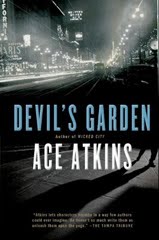 With vivid, economical prose, Atkins weaves together multiple viewpoints including those of Hearst and Arbuckle himself. Most impressive is the perspective of young Pinkerton operative Dashiell Hammett, then known as Sam. Atkins incorporates many clues about the writer Hammett would become without detracting from the story at hand. And he finds ways of surprising you even if you’re already familiar with the sad facts of the case.
With vivid, economical prose, Atkins weaves together multiple viewpoints including those of Hearst and Arbuckle himself. Most impressive is the perspective of young Pinkerton operative Dashiell Hammett, then known as Sam. Atkins incorporates many clues about the writer Hammett would become without detracting from the story at hand. And he finds ways of surprising you even if you’re already familiar with the sad facts of the case.
Nothing is better than discovering an established author who is new to you. I now have Atkins’ Nick Travers series as well as his other historical novels including Infamous, the upcoming one about “Machine Gun” Kelly, to look forward to. Here’s his blog.
Tuesday, January 12, 2010
Movie: Best Seller (1987)
Time again for a question that’s a hobbyhorse around here: whatever happened to sleaze? Where’s a guy gotta go to get served up a cocktail of sex, violence and cynicism? Oh, right. Videogames. If I want the cinematic variety, I have to return to the cable staples of my youth.
In Best Seller, Brian Dennehy plays Joseph Wambaugh Dennis Meechum, L.A. cop and successful author. He’s suffering from writer’s block when the perfect story saunters into his life in the form of Cleve (James Woods). Cleve claims to be the in-house assassin for a huge conglomerate and its pillar of the community founder. (“Corporations deal in two things, assets and liabilities. I eliminated the liabilities, and I provided some of the assets.”) As aggrieved as a top salesman passed over for promotion, Cleve has decided to bring the entire enterprise down by collaborating with Meechum on a book – whether Meechum wants to or not.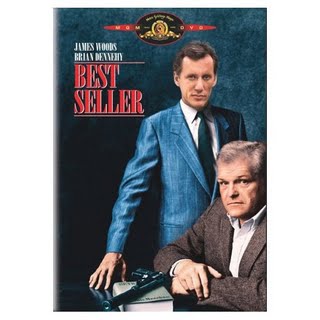 Best Seller was directed by John Flynn, who brought astonishing fidelity to Richard Stark’s Parker in the tragically still-not-on-video The Outfit. The script is by personal hero Larry Cohen, which means it moves with ferocious energy while still having time for crackpot diversions. Like Woods singing in French and a visit to the hit man’s parents. Cohen wrote the film for Kirk Douglas and Burt Lancaster but Larry, bless his B-movie heart, can only work in fast-and-cheap mode. The result is the most underpopulated conspiracy movie ever. It’s basically just two guys.
Best Seller was directed by John Flynn, who brought astonishing fidelity to Richard Stark’s Parker in the tragically still-not-on-video The Outfit. The script is by personal hero Larry Cohen, which means it moves with ferocious energy while still having time for crackpot diversions. Like Woods singing in French and a visit to the hit man’s parents. Cohen wrote the film for Kirk Douglas and Burt Lancaster but Larry, bless his B-movie heart, can only work in fast-and-cheap mode. The result is the most underpopulated conspiracy movie ever. It’s basically just two guys.
But what guys. Dennehy and Woods are the Hope and Crosby of mayhem. Woods has never been better, playing a true sociopath who is utterly ruthless yet has kind words for the little people and praise for the American dream. Watch his reaction, both deeply hurt and enraged, when Dennehy refuses a gift. This strange hybrid of thriller and jet-black buddy comedy also ventures into meta terrain thanks to Cleve’s obsession with coming across as a sympathetic character.
There are movies with more sleaze, but what’s here – like Cleve’s pickup of a woman in a bar – is cherce. And for a jaundiced view of how the world works, it can’t be beat.
Dennehy is still going strong at age 71, currently onstage in Chicago doing O’Neill and Beckett. I’d like to see him return as the head of the show-within-the-show’s Teamster crew on 30 Rock. Here’s a recent interview in which he demonstrates that good ol’ Irish Catholic fatalism that’s like mother’s milk to me.
Sunday, January 10, 2010
Upcoming: Noir City 8
San Francisco at the end of this month, Seattle in February. First warning: yours truly will be working the SIFF Cinema lobby. Also, I’ll be selling FNF goodies.
Here’s the promo, featuring 2009’s Miss Noir City Alycia Tumlin and the man himself, Eddie Muller.
Saturday, January 09, 2010
Book: A Bright and Guilty Place, by Richard Rayner (2009)
Rayner’s history of 1920s and ‘30s Los Angeles is wrapped, naturally, around corruption and reinvention. Leslie White is an investigator for the D.A.’s office who becomes a pulp author. (When he needs help breaking into the racket, he gets in touch with his old lawyer friend Erle Stanley Gardner.) Dave Clark is a golden boy war hero turned prosecutor who ends up charged with the murder of L.A.’s criminal kingpin.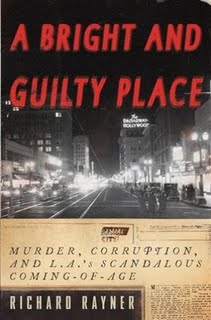 The book brims with fascinating information, but it’s also disjointed. There are a few scandals too many. The lives of the two central figures don’t have that much overlap. Clark’s trial is anticlimactic while the bizarre events in its wake are treated as an afterthought. Raymond Chandler is frequently cited even though his relation to the proceedings is tangential.
The book brims with fascinating information, but it’s also disjointed. There are a few scandals too many. The lives of the two central figures don’t have that much overlap. Clark’s trial is anticlimactic while the bizarre events in its wake are treated as an afterthought. Raymond Chandler is frequently cited even though his relation to the proceedings is tangential.
Ultimately it’s Chandler’s vision of Los Angeles, seductive and treacherous, that Rayner understands intuitively and captures very well. For all its flaws as a history of a time, the book succeeds as a chronicle of a mood. Many people have contrasted Rayner’s book with L.A. Noir by John Buntin, which picks up the City of Angels’ story where Rayner leaves off. Rayner’s book is better written, Buntin’s more cohesive. Together they offer a compelling account of Los Angeles as it was not only inventing itself, but 20th century America.
Some of White’s stories are collected in The Black Lizard Big Book of Pulps. I’ll say this for them: they have a certain energy. Here’s the opening line from “The City of Hell!,” published in the October 1935 issue of Black Mask and influenced by L.A.’s endemic graft.
The piercing screams of a woman filled the awed hollow of silence left void by the chatter of a sub-machine-gun and acted as a magnet of sound to suck the big squad car to the scene.
Rayner recently led the Guardian on a tour of locations from the book. And here he is on Ben Hecht.
Monday, January 04, 2010
Movie: District 13: Ultimatum (U.S. 2010)
Typically it’s several weeks into January before I see my first film released in that calendar year. 2008: Cloverfield, January 26. 2009: Taken, January 31.
But we are out of the dark ages, brothers and sisters. Let it be known that, through the miracle of On Demand, in 2010 I saw a 2010 release on January 1. I know it’s not exactly a flying car or a sassy robot maid. But I’m still kind of impressed.
In Luc Besson’s District 13: Ultimatum, there’s another conspiracy to annihilate one of Paris’s lesser, more polyglot precincts. Once again supercop Damien must team up with neighborhood hero Leito to save the day. There’s not as much parkour as in the original, I missed the grittiness of the first film, and the third act – in which District 13’s many ethnic gangs unite to raid a French seat of power guarded by soldiers who don’t use their guns – is completely ridiculous. Not bad, mind you, just ridiculous. On the plus side there’s a fight using a Van Gogh, and I am now in love with Elodie Yung of the razors in her ponytail. I have also been informed by a party who shall remain Rosemarie nameless that the sight of Cyril Raffaelli in go-go dancer drag not only justified the expense but may warrant a second look on the big screen.
At one point Raffaelli mentions that he’s about to be thrown into “a local Guantanamo,” and the bad guys are crooked cops allied with a military contractor called, I kid you not, Harriburton. America, the new global shorthand for movie villainy. Technology’s not the only thing that’s changed.